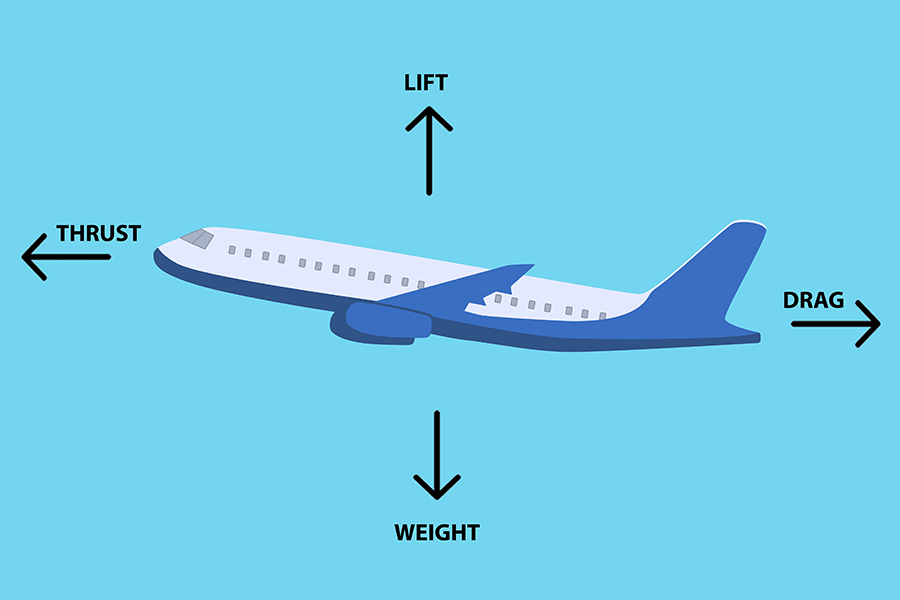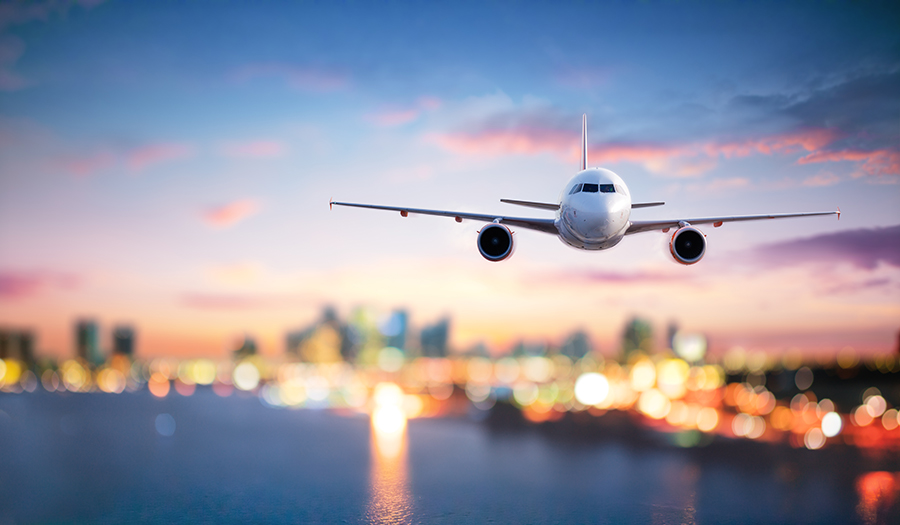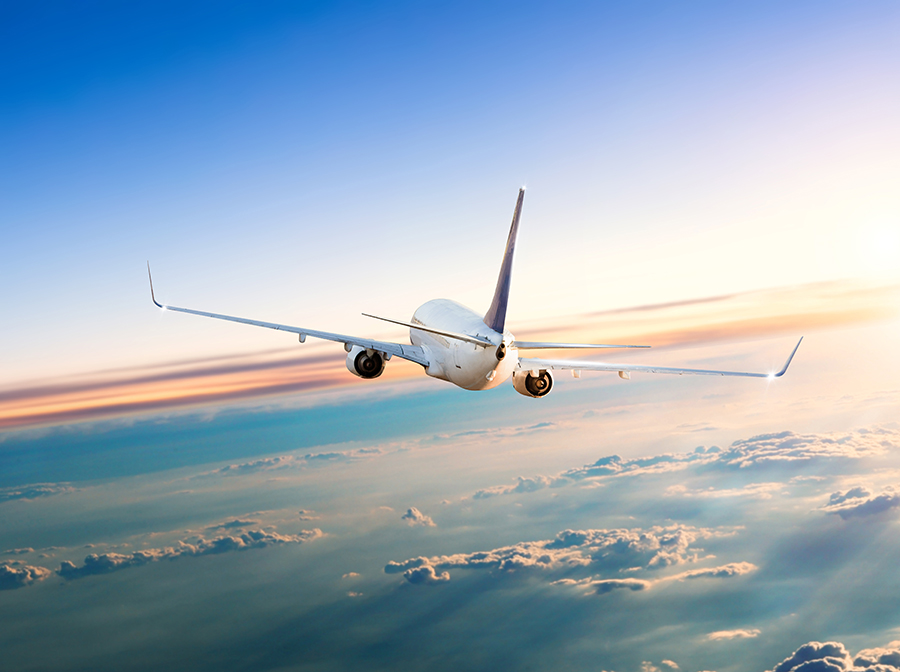4 Forces On A Plane
While a lot is going on when an airplane gets airborne, yous might be surprised to larn that there are merely iv forces involved when discussing the principle of flight. We are going to brand understanding them easy. Today we will tell you everything you need to know almost all 4 forces of flight, how they interact and what happens in various flight phases.
The Principle of Flying
The four forces making up the principle of flight are lift, weight, drag, and thrust. The forces all interact together to make up one's mind an aeroplane'southward trajectory. Lift and weight are opposing forces, as are thrust and drag. All are equally important, and they must be balanced to maintain level flight.
While the 4 forces oppose each other, they don't all act exactly the opposite.
The bottom line?
Some forces (such as thrust) supplement other forces (such as lift) in certain circumstances.
Once you know nearly the principle of flying, and the four forces, understanding what happens to the airplane is relatively easy. Knowing a niggling about how a wing generates lift can as well be beneficial. And for that, we need to refer to a gentleman called Daniel Bernoulli.
Here'due south what you need to know…
What is Bernoulli'southward Principle of Flight?
Bernoulli's principle of flight is a uncomplicated concept to empathise. Bernoulli'south theory states that if a fluid flow speeds up, at that place is a pressure drib. Air acts simply like a fluid. For aviators, this means that if the air is sped up above a wing, then in that location is a lower pressure above the fly than below.
This speeding up is caused by the wings slant, a fancy aviation term that means 'curved on summit'. A curved line is longer than a straight line, meaning the air must travel farther to get to the wing'due south trailing edge.
Or, to put it in really bones terms, the air speeds upward.
What practice yous think happens if there is high pressure beneath the fly and depression pressure level on meridian?
The wing moves up into the surface area of depression pressure, and nosotros call this strength lift.
What are the iv Principles of Flight?

Four forces work together to determine an shipping's beliefs. Lift, weight, thrust and elevate. These forces, in isolation, are relatively simple to empathise. Once y'all know virtually them, their interaction and effect on an plane are relatively straightforward.
Below you will detect a list detailing each principle of flight. We volition explicate the direction in which the force acts, its opposing force, and the factors that affect how swell the force is.
Before we brainstorm, it is useful to briefly talk over a couple of terms that will help our understanding of the principle of flying. We'll be using them often.
And they are…
Vectors
Sounds complex, correct? Trust us, it isn't.
To keep it simple, a 'vector' is an imaginary line that has two characteristics: –
- A vector acts in a given direction
- A vector has a given strength or magnitude
That'due south it! Vectors can combine to produce resultant forces.
Resultant Forces
Resultant forces are the combination of two vectors.
Two vectors at 90 degrees to each other form two sides of a correct-angle triangle. The hypotenuse is the resultant force.
To keep it simple. If you increase whatsoever vector, the resultant strength will abound.
Why do we need to know about resultant forces?
The easy answer is that no principle of flight exists in isolation. They all interact. Understanding resultant forces make it piece of cake to determine what volition happen to the aircraft.
Here are the 4 forces involved in the principle of flight, their effects, and how they work.
Lift
Vector Acts Through: The Centre of Force per unit area
Vector Direction: xc° to the relative airflow
Opposing forces: Weight
Things that Influence Lift:
- Airspeed
- Angle of assail
- Wing Size
- Air Density
Okay, so information technology's a little obvious, but the lift is a good place to showtime as we are talking airplanes.
Lift is vital to ensuring sustained flying. Information technology is more often than not generated by the wings, but smaller elements of lift are generated past the horizontal stabilizer and even the fuselage.
Elevator acts through the centre of pressure level and at xc° to the relative airflow.
Recollect that concluding judgement. It's important. We'll explain why in a minute.
Wings aren't entirely equal and change in shape from the root to the tip. As a effect, they generate different amounts of lift. The heart of pressure describes the sum of these unlike amounts. It is oftentimes expressed using the fly's chord line as a reference.
At present…
Y'all would be forgiven for thinking that lift always acts direct upwards.
But…
Remember what we said higher up? Here, let us repeat information technology. Lift always acts 90° to the relative airflow. Normally this is the frontward direction in which the fly is moving.
So, if the aeroplane is inverted, the wing would really generate lift in a downward direction. Likewise, if information technology was flying vertically straight up, the elevator vector would act towards the horizon!
Why is this such an important concept to understand?
Considering where the lift vector is oriented has a huge impact on how the aircraft behaves. While information technology can act opposite to weight, information technology can also work in the aforementioned management or requires the awarding of some other strength to ensure sustained flying.
Check our section below on straight and level and climbing and descending to come across really excellent examples.
Weight
Vector Acts Through: Heart of Gravity
Vector Direction: Always towards the Center of the Earth
Opposing force: Lift
Things that Bear on Weight:
- How much mass is placed on board an aircraft, including passengers, baggage, fuel, and equipment?
Weight is a relatively simple concept to understand. The more items on board the aircraft, and the greater their mass, the greater their weight.
Every item is summed together to make upwardly how much the aircraft weighs. But where does this forcefulness act?
Easy, through the eye of gravity.
The centre of gravity is the point through which all forces of weight act. An easy way to empathise it? Consider the 'pivot' signal through which the weight acts, much like the central pivot on a see-saw. The aeroplane also turns around its center of gravity.
Information technology is vital to note…
The middle of gravity always acts towards the earth'southward center, regardless of the aircraft'southward attitude or orientation.
Elevate
Vector Acts Through: Center of pressure level, ninety° to the eye of the lift vector
Vector Direction: Rearward
Opposing force: Thrust
Things that Affect Drag:
- Air density
- Shipping Shape
- Airspeed
- How much lift is existence produced
Drag acts in a rearward direction, contrary to the direction in which the shipping is traveling.
Drag is fabricated up of numerous parts. Some are caused by the shape of an object moving through the air (form drag), whereas others come as a by-product of lift (induced drag).
You tin can read more most drag hither. (NEEDS LINK)
Thrust
Vector Acts Through: Heart of Thrust
Vector Direction: Forrard in the direction that the engine is pointing
Opposing force: Drag
Things that Affect Thrust:
- Engine RPM
- Airspeed
- Air Density
- Altitude
The thrust vector acts in a forward direction and is normally generated by the plane engine. By calculation thrust (by pushing the throttle forward), we tin can increase the thrust vector, making the aircraft move faster.
By at present, the hawkeye-eyed amid you will have gathered that changing one of the vectors will affect the others.
But here'south the thing (and it's what makes flying so fun).
An aeroplane is super dynamic. It can move in 3 dimensions with unlimited possibilities! And explaining each and every possible combination is almost incommunicable.
And then…
Nosotros need a starting point where nosotros can easily see what is going on when because the principle of flight. From at that place, we can explain what happens when something changes in bones terms.
And we call that point…
"Directly and level"…
Straight and Level – The Counterbalanced four Forces

So, we are saturday on a flying, on the cruise, staring out of the window with a coke in one hand and a pack of nuts in the others.
Lovely.
While it'due south nice inside the airplane, let's call up about what is going on exterior the shipping. It's all nearly beingness balanced.
Straight and level flight is the perfect example of what happens when all the flight forces are in equilibrium.
Before we look at the principles of flight, permit's remember almost what happens when we fly direct and level. In the about bones terms: –
- The aircraft is not climbing, nor is it descending
- The aircraft is neither speeding upward nor slowing downwardly.
That tin simply mean i thing.
Every force is equally matching its opposite.
Want it in slightly more technical terms?
- The lift vector is the aforementioned size in magnitude as its opposing force (weight)
- The thrust vector is exactly matching the drag vector
To visualize this concept, imagine a simple cross running vertically and horizontally. The vertical axis represents lift and weight. The horizontal axis, thrust, and drag.
All the lines or 'vectors' are the same lengths.
See, we told yous it was easy!
Got a general concept? Permit'southward throw a climb and a descent into the mix and see what changes…
What Are the Forces of Flying in a Climb?
To climb, two things need to happen when discussing the principle of flight: –
- The lift vector must exceed the weight vector
- The thrust must exceed the drag
To do this, the pilot does ii things: –
- They pitch the aircraft up (increasing the angle of assail and, therefore, the elevator the wing produces)
- They increase the thrust (preventing speed the speed from decreasing)
Imagining our 'cross' we described above, 2 of the lines increase in size. Two vectors (lift and thrust) increasing cause a resultant force.
What management do you recall this resultant forcefulness acts in?
"Up" is the correct answer. Withal, there is a piffling more than to the story…
Why?
Remember what we said about the direction of the lift vector and where it is oriented?
It is at xc° to the relative airflow.
If the plane is climbing, the fly has a higher angle of attack, and therefore the lift vector is not, in fact, pointed direct up.
We tin also surmise that information technology is non acting directly opposite to the weight vector (which always points directly down through the centre of gravity).
But, above, we said that the elevator vector must exceed the weight vector for the aeroplane to ascend?
It goes something like this.
The thrust vector generally acts in the direction the airplane is pointing. With the nose raised, the resultant force of the thrust and lift combines to overcome the weight, causing the plane to climb.
What Are the Forces of Flying in a Descent?

The flight forces in descent are easy to empathize.
The plane fly is generating some lift, but this is exceeded by the aircraft's weight. The thrust vector will also be small-scale, and if the airplane is pointed the olfactory organ down, the resultant force of the thrust and weight combined will exceed the lift produced.
Again, information technology is important to note that the weight vector always acts straight down. And then, unless the lift and thrust vectors (or the resultant strength of the 2) exceed the weight, the airplane will always descend.
Desire proof of the above concept?
When making a turn in an airplane, you volition have to utilise power (increasing the thrust) and pull back slightly on the stick (increasing the lift).
This is considering when the airplane is rolled, the lift vector points in a direction that is non directly opposing the weight vector. If y'all didn't employ power and back-stick, the airplane would plough, but it would also descend!
Last Thoughts
The principle of flight isn't too complex. At that place are only iv forces to remember; lift, weight, thrust, and drag. These forces collaborate and are all linked. How they are combined determines the behavior of the airplane. The aerodynamic theory doesn't accept to be complex. Want more proof? Check out our online courses. They brand learning aviation theory actually easy, and you lot tin can fifty-fifty complete them at home!
4 Forces On A Plane,
Source: https://pilotinstitute.com/principles-of-flight/
Posted by: robinsonbitterephe56.blogspot.com


0 Response to "4 Forces On A Plane"
Post a Comment